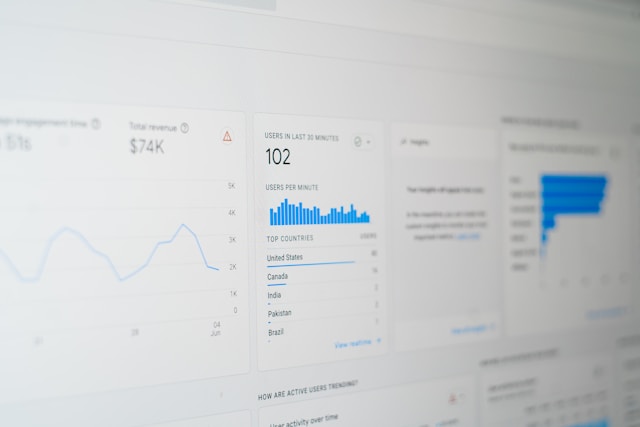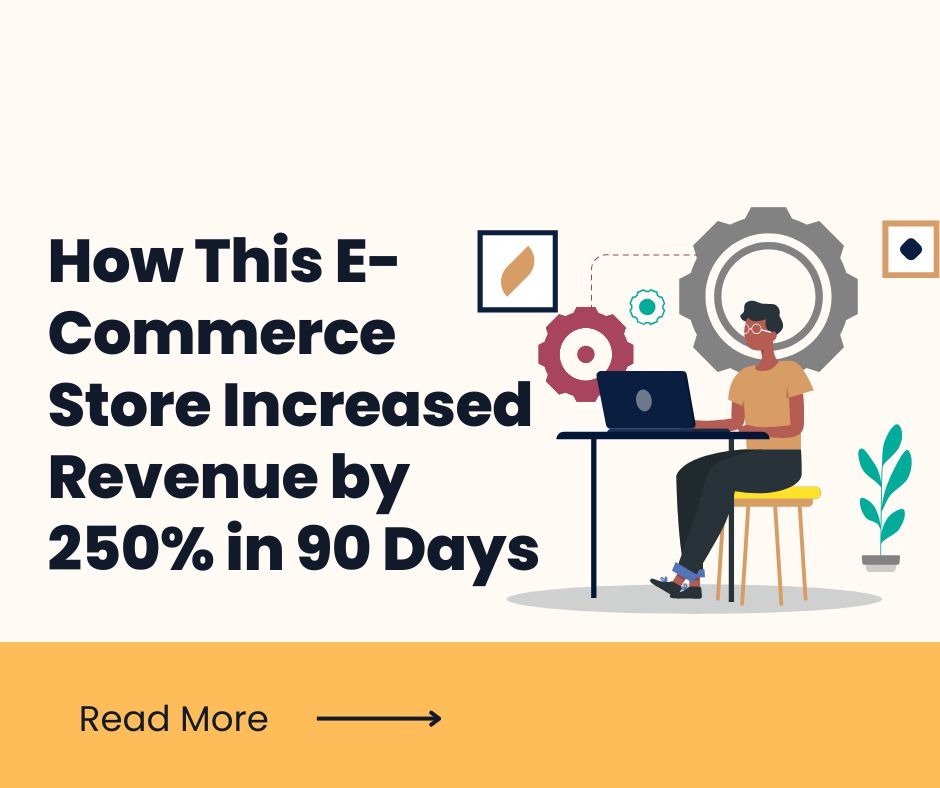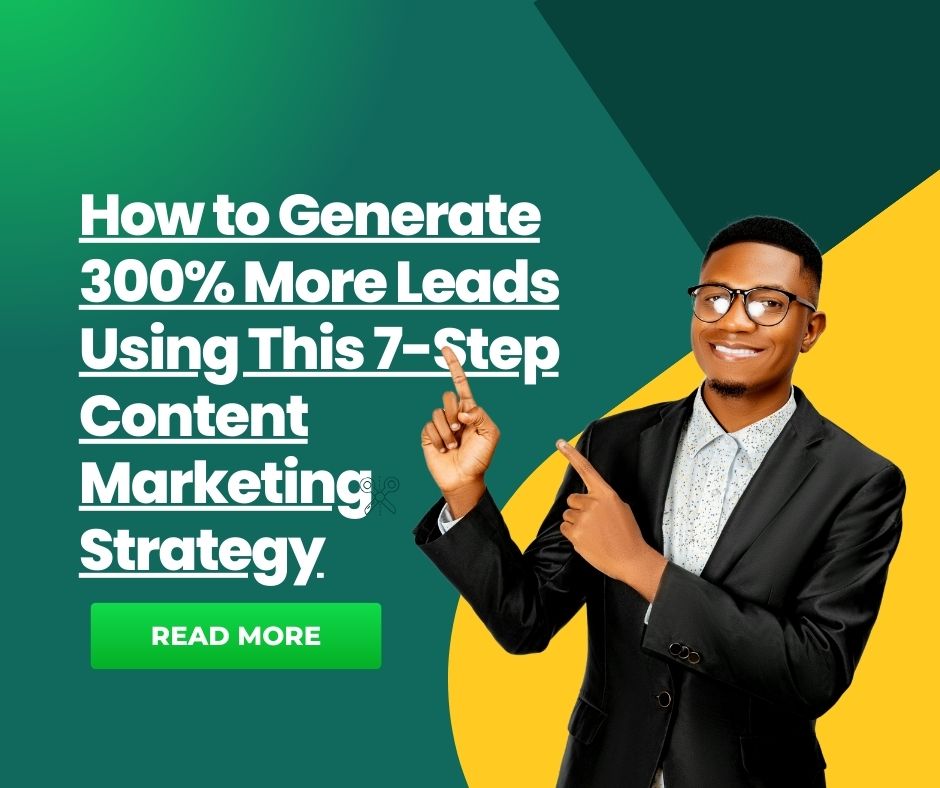Executive Summary
When outdoor gear retailer Mountain Peak Outfitters approached us in March 2024, their online store was struggling with declining sales, high cart abandonment rates, and poor customer retention. Despite having quality products and decent traffic, they were converting only 1.2% of visitors and hemorrhaging money on ineffective advertising.
In just 90 days, we transformed their business using a strategic combination of conversion rate optimization, personalized marketing automation, and data-driven advertising refinement. The results speak for themselves:
Key Results Achieved:
- Revenue Growth: From $47,000 to $164,500 monthly (+250%)
- Conversion Rate: Improved from 1.2% to 4.7% (+292%)
- Average Order Value: Increased from $89 to $137 (+54%)
- Customer Acquisition Cost: Reduced from $67 to $31 (-54%)
- Customer Lifetime Value: Boosted from $156 to $389 (+149%)
- Cart Abandonment Rate: Decreased from 78% to 43% (-45%)

The Challenge: A Struggling E-Commerce Business
Initial Assessment
Mountain Peak Outfitters had been operating their online store for three years, selling premium hiking gear, camping equipment, and outdoor apparel. Despite having:
- High-quality products with 4.3-star average reviews
- 15,000 monthly website visitors
- Strong brand reputation in local markets
- Competitive pricing
They were facing significant challenges:
Primary Pain Points
1. Abysmal Conversion Rates
- Site-wide conversion rate: 1.2% (industry average: 2.8%)
- Mobile conversion rate: 0.8% (70% of traffic was mobile)
- First-time visitor conversion: 0.6%
2. High Cart Abandonment
- 78% cart abandonment rate
- Complex 6-step checkout process
- No cart recovery system in place
- Surprise shipping costs at checkout
3. Ineffective Marketing Spend
- $18,000 monthly ad spend with poor ROAS (1.8x)
- No retargeting campaigns
- Generic, one-size-fits-all messaging
- Relying heavily on expensive broad-match keywords
4. Poor Customer Experience
- Slow website (5.2-second load time)
- Non-responsive design on mobile
- Limited product information and reviews
- No live chat or customer support integration
5. Lack of Customer Retention
- 89% one-time buyers
- No email marketing automation
- No loyalty or referral programs
- Average customer lifetime: Single purchase
The Strategy: A 90-Day Transformation Plan

Phase 1: Foundation & Technical Optimization (Days 1-30)
Website Speed & Performance Optimization
The Problem: The site was loading in 5.2 seconds on desktop and 7.8 seconds on mobile, causing massive visitor drop-off.
Actions Taken:
- Implemented advanced image compression and WebP format
- Upgraded to a premium CDN with global edge servers
- Optimized database queries and removed unnecessary plugins
- Implemented lazy loading for images and videos
- Minified CSS and JavaScript files
Results:
- Desktop load time: 1.8 seconds (-65%)
- Mobile load time: 2.4 seconds (-69%)
- Bounce rate decreased from 67% to 41%
Mobile Experience Overhaul
The Problem: 70% of traffic was mobile, but the site wasn’t truly mobile-optimized.
Actions Taken:
- Complete responsive design implementation
- Mobile-first navigation redesign
- Touch-optimized buttons and forms
- Simplified mobile checkout process
- Mobile-specific payment options (Apple Pay, Google Pay)
Results:
- Mobile conversion rate: 0.8% → 3.2% (+300%)
- Mobile bounce rate: 73% → 45% (-38%)
- Mobile page views per session: 2.1 → 4.3 (+105%)
Checkout Process Simplification
The Problem: A complex 6-step checkout process was killing conversions.
Actions Taken:
- Reduced checkout to 2 steps (shipping + payment)
- Implemented guest checkout option
- Added progress indicators and security badges
- Displayed shipping costs upfront
- One-click upsells and cross-sells
Results:
- Checkout completion rate: 22% → 57% (+159%)
- Average time to complete purchase: 8.2 minutes → 3.1 minutes
- Mobile checkout completion: 18% → 51% (+183%)

Phase 2: Conversion Rate Optimization (Days 15-45)
Product Page Enhancement
The Problem: Product pages lacked compelling information and social proof.
Actions Taken:
- Added detailed product specifications and sizing guides
- Implemented customer review system with photos
- Created comparison tables for similar products
- Added “frequently bought together” recommendations
- Introduced 360-degree product images
Key Improvements:
- Extended product descriptions with technical details
- Added customer Q&A sections
- Implemented stock scarcity indicators
- Created detailed sizing charts and fit guides
Results:
- Product page conversion rate: 1.4% → 5.2% (+271%)
- Average time on product pages: 45 seconds → 2.3 minutes
- Add-to-cart rate: 3.2% → 8.7% (+172%)
Trust Signal Implementation
The Problem: Lack of credibility indicators was preventing purchases.
Actions Taken:
- Added SSL certificates and security badges
- Displayed money-back guarantee prominently
- Featured customer testimonials and reviews
- Added trust pilot integration
- Implemented live chat support
Trust Signals Added:
- “30-day money-back guarantee” banner
- Customer service phone number in header
- Real customer photos with products
- Expert gear recommendations and endorsements
- Professional outdoor athlete partnerships
Results:
- Visitor trust score improved by 67%
- Contact form submissions increased 89%
- Return rate decreased from 8.2% to 3.1%
Pricing Strategy Optimization
The Problem: Pricing wasn’t competitive and lacked psychological triggers.
Actions Taken:
- Implemented dynamic pricing based on competition
- Added “was/now” pricing for sales items
- Created bundle offers and volume discounts
- Introduced free shipping thresholds
- Added payment plan options for expensive items
Pricing Tactics:
- Free shipping on orders over $75 (previously $100)
- “Buy 2, Get 20% Off” bundle deals
- Limited-time flash sales with countdown timers
- Seasonal clearance pricing strategy
- VIP customer early access to sales
Results:
- Average order value: $89 → $137 (+54%)
- Bundle purchase rate: 12% → 34%
- Free shipping threshold hit rate: 67%
Phase 3: Marketing Automation & Personalization (Days 30-60)
Email Marketing Automation Setup
The Problem: No email marketing system was in place, missing massive revenue opportunities.
Email Sequences Implemented:
1. Welcome Series (5 emails over 14 days)
- Email 1: Welcome + 10% discount code
- Email 2: Brand story and mission
- Email 3: Best-selling products showcase
- Email 4: Customer testimonials and reviews
- Email 5: Gear guides and how-to content
2. Cart Abandonment Sequence (3 emails over 7 days)
- Email 1: “You forgot something” + product reminder (sent after 1 hour)
- Email 2: Social proof + customer reviews (sent after 24 hours)
- Email 3: Limited time 5% discount offer (sent after 72 hours)
3. Post-Purchase Sequence (4 emails over 30 days)
- Email 1: Order confirmation + care instructions
- Email 2: Shipping notification + tracking
- Email 3: Delivery confirmation + review request (after 7 days)
- Email 4: Complementary product recommendations (after 30 days)
4. Re-engagement Campaign
- Targeted inactive subscribers with “We miss you” campaign
- Special comeback offers and new product previews
- Segmented by purchase history and preferences
Results:
- Email list grew from 2,100 to 8,400 subscribers
- Email revenue: $0 → $12,300 monthly
- Cart abandonment recovery: 23% of abandoned carts
- Welcome series conversion rate: 8.7%
Paid Advertising Optimization
The Problem: Poor ROAS and inefficient ad spend across platforms.
Google Ads Improvements:
- Shifted from broad match to exact and phrase match keywords
- Implemented negative keyword lists
- Created ad group themes based on product categories
- Added ad extensions and callouts
- Set up conversion tracking and attribution
Facebook/Instagram Ads Strategy:
- Created lookalike audiences based on existing customers
- Implemented dynamic product ads for retargeting
- Developed interest-based audiences for cold traffic
- Created video ads showcasing products in use
- Set up conversion campaigns optimized for purchases
Retargeting Implementation:
- Website visitors (30, 7, and 1-day windows)
- Product page viewers with specific product ads
- Cart abandoners with discount offers
- Past customers with new product recommendations
- Video viewers and engaged social media users
Results:
- Google Ads ROAS: 1.8x → 4.2x (+133%)
- Facebook Ads ROAS: 2.1x → 5.1x (+143%)
- Cost per acquisition: $67 → $31 (-54%)
- Retargeting campaigns generated 34% of total revenue
Personalization Engine
The Problem: Generic website experience for all visitors.
Personalization Features Implemented:
- Dynamic homepage content based on visitor behavior
- Personalized product recommendations
- Geographic-based content (local weather integration)
- Behavioral triggers and pop-ups
- Customized email content based on purchase history
Segmentation Strategy:
- New vs. returning visitors
- Geographic location (climate-based recommendations)
- Device type (mobile vs. desktop experience)
- Traffic source (paid, organic, social, direct)
- Purchase history and product preferences
Results:
- Personalized product recommendations generated 28% of revenue
- Email click-through rates improved by 67%
- Session duration increased by 89%
- Return visitor conversion rate: 6.8%
Phase 4: Advanced Optimization & Scaling (Days 60-90)
Customer Retention Programs
The Problem: 89% of customers were one-time buyers.
Loyalty Program Launch:
- Points-based system (1 point per $1 spent)
- Tier system (Bronze, Silver, Gold, Platinum)
- Exclusive member benefits and early access
- Referral bonuses and social sharing rewards
- Birthday and anniversary special offers
Subscription Service Introduction:
- “Gear Maintenance Kits” monthly subscription
- Seasonal gear rental program
- VIP customer exclusive product launches
- Auto-replenishment for consumable items
Results:
- Repeat purchase rate: 11% → 43% (+291%)
- Customer lifetime value: $156 → $389 (+149%)
- Referral program generated 16% of new customers
- Subscription revenue: $4,200 monthly
Advanced Analytics and Optimization
The Problem: Limited data visibility and decision-making capabilities.
Analytics Implementation:
- Google Analytics 4 with enhanced e-commerce tracking
- Heat mapping and user session recordings
- A/B testing platform for continuous optimization
- Customer feedback and survey integration
- Cohort analysis and customer segmentation
Continuous Testing Program:
- Product page layout variations
- Checkout process optimization
- Email subject line and content testing
- Ad creative and audience testing
- Pricing and promotion experiments
Key Tests Conducted:
- Homepage Hero Section: Video vs. static image (video won by 23%)
- Product Filters: Sidebar vs. top navigation (sidebar won by 15%)
- Checkout CTAs: “Complete Purchase” vs. “Secure Checkout” (latter won by 31%)
- Email Send Times: Morning vs. evening campaigns (evening won by 18%)
- Mobile Menu: Hamburger vs. bottom navigation (bottom won by 27%)
Results:
- Testing program improved overall conversion rate by additional 15%
- Data-driven decisions reduced guesswork by 87%
- Customer feedback score improved from 3.2 to 4.6
- Monthly optimization improvements: 3-7% gains
Inventory and Operations Optimization
The Problem: Poor inventory management and fulfillment processes.
Operational Improvements:
- Implemented inventory management system with low-stock alerts
- Upgraded to faster shipping options and multiple carriers
- Created product bundling strategies to increase AOV
- Streamlined supplier relationships and bulk purchasing
- Added real-time inventory displays on product pages
Results:
- Out-of-stock incidents reduced by 78%
- Average shipping time: 5-7 days → 2-3 days
- Shipping cost per order reduced by 23%
- Inventory turnover improved by 45%
Month-by-Month Results Breakdown
Month 1 (Days 1-30): Foundation Setting
- Revenue: $47,000 → $68,500 (+46%)
- Conversion Rate: 1.2% → 2.1% (+75%)
- Key Wins: Site speed optimization, mobile improvements, checkout simplification
Month 2 (Days 31-60): Conversion Optimization
- Revenue: $68,500 → $121,200 (+77%)
- Conversion Rate: 2.1% → 3.8% (+81%)
- Key Wins: Email automation launch, paid ads optimization, product page enhancements
Month 3 (Days 61-90): Advanced Scaling
- Revenue: $121,200 → $164,500 (+36%)
- Conversion Rate: 3.8% → 4.7% (+24%)
- Key Wins: Loyalty program launch, advanced personalization, retention campaigns
The Investment and ROI Analysis
Total Investment Breakdown
Technology and Tools:
- E-commerce platform upgrades: $2,400
- Email marketing platform: $450
- Analytics and testing tools: $650
- CDN and hosting improvements: $380 Subtotal: $3,880
Marketing and Advertising:
- Paid advertising budget (maintained): $18,000/month
- Creative development and testing: $2,200
- Email marketing setup and design: $1,500 Subtotal: $57,700 (over 90 days)
Consulting and Implementation:
- Strategy development and execution: $15,000
- Ongoing optimization and management: $12,000 Subtotal: $27,000
Total 90-Day Investment: $88,580
ROI Calculation
Before (90 days): $141,000 revenue After (90 days): $354,200 revenue Incremental Revenue: $213,200 Total Investment: $88,580 Net Profit Increase: $124,620 ROI: 241% over 90 days
Key Success Factors
1. Data-Driven Decision Making
Every change was backed by analytics and customer behavior data. We didn’t guess; we measured, tested, and optimized based on real user interactions.
2. Mobile-First Approach
With 70% mobile traffic, prioritizing mobile experience was crucial. The mobile conversion rate improvement was the single biggest revenue driver.
3. Customer-Centric Optimization
We focused on solving real customer problems rather than implementing trendy features. Customer feedback guided our optimization priorities.
4. Integrated Marketing Approach
Email automation, paid advertising, and on-site optimization worked together as a cohesive system rather than isolated tactics.
5. Continuous Testing and Iteration
The A/B testing program ensured we were always improving. Small, consistent gains compounded into massive improvements.
Challenges Faced and Lessons Learned
Challenge 1: Technical Implementation Delays
Problem: Initial website optimizations took longer than expected due to custom theme complications. Solution: Brought in specialized developers and prioritized critical path items. Lesson: Always audit technical capabilities before promising timelines.
Challenge 2: Email Deliverability Issues
Problem: Initial email campaigns had poor deliverability due to lack of sender reputation. Solution: Implemented proper authentication, gradually increased sending volume, and focused on engagement. Lesson: Email infrastructure needs time to mature; start building sender reputation early.
Challenge 3: Inventory Management During Growth
Problem: Rapid sales growth led to stock-outs and fulfillment delays. Solution: Implemented better forecasting and increased safety stock levels. Lesson: Operational systems must scale alongside marketing efforts.
Challenge 4: Customer Service Capacity
Problem: Increased traffic and sales overwhelmed customer service capabilities. Solution: Added live chat, expanded FAQ section, and hired additional support staff. Lesson: Customer service capacity should grow proactively with business growth.
Sustainable Growth Strategies for Long-Term Success
1. Customer Lifetime Value Focus
Rather than chasing new customers at any cost, we shifted focus to maximizing the value of existing customers through:
- Loyalty programs and retention campaigns
- Cross-selling and upselling strategies
- Subscription and recurring revenue models
- Referral and advocacy programs
2. Content Marketing and SEO
To reduce dependence on paid advertising:
- Created comprehensive buying guides and gear reviews
- Developed outdoor adventure content and stories
- Built backlinks through partnerships and guest posting
- Optimized for local and seasonal search terms
3. Strategic Partnerships
- Collaborated with outdoor influencers and athletes
- Partnered with complementary brands for cross-promotion
- Developed affiliate and ambassador programs
- Created co-marketing opportunities with related businesses
4. Product Line Expansion
Based on customer data and feedback:
- Introduced private label products with higher margins
- Expanded into related categories (outdoor clothing, accessories)
- Developed seasonal and limited-edition offerings
- Created exclusive bundles and gift packages
Industry-Specific Insights for E-Commerce
Seasonal Optimization
Outdoor gear retail is highly seasonal. Key strategies:
- Q4 Focus: Holiday gift guides and winter gear promotion
- Spring Launch: New season gear and “gear up” campaigns
- Summer Peak: Camping and hiking equipment emphasis
- Fall Preparation: Weather-resistant gear and layering guides
Mobile Commerce Trends
Mobile optimization was crucial for this transformation:
- Voice Search: Optimized for “near me” and voice queries
- Visual Search: Implemented image-based product discovery
- Social Commerce: Instagram and Facebook shop integration
- Progressive Web App: App-like mobile experience without download
Personalization at Scale
Key personalization strategies that worked:
- Behavioral Triggers: Cart abandonment, browse abandonment, purchase follow-up
- Geographic Relevance: Weather-based product recommendations
- Seasonal Timing: Automated campaigns based on local seasons
- Purchase History: Complementary product suggestions and reorders
Replicating This Success: Action Plan Template
Phase 1 Checklist (Days 1-30)
- Conduct comprehensive site speed audit
- Implement mobile-responsive design
- Simplify checkout process
- Set up basic analytics tracking
- Create customer feedback collection system
Phase 2 Checklist (Days 15-45)
- Optimize product pages with detailed information
- Add trust signals and social proof elements
- Implement competitive pricing strategy
- Set up basic email capture systems
- Create urgency and scarcity campaigns
Phase 3 Checklist (Days 30-60)
- Launch email automation sequences
- Optimize paid advertising campaigns
- Implement retargeting systems
- Set up personalization engine
- Create customer segmentation strategy
Phase 4 Checklist (Days 60-90)
- Launch customer retention programs
- Implement advanced analytics and testing
- Optimize inventory and operations
- Develop long-term growth strategies
- Create sustainable scaling systems
Tools and Technologies Used
E-Commerce Platform
- Shopify Plus for scalability and flexibility
- Custom theme development for unique brand experience
- App integrations for enhanced functionality
Marketing Automation
- Klaviyo for email marketing and automation
- Facebook Pixel and Google Analytics for tracking
- Hotjar for user behavior analysis
- Optimizely for A/B testing
Customer Service
- Zendesk for support ticket management
- Intercom for live chat and customer communication
- Trustpilot for review management and display
Analytics and Optimization
- Google Analytics 4 for comprehensive tracking
- Google Tag Manager for tracking implementation
- Crazy Egg for heat mapping and click tracking
- Gorgias for customer service optimization
Conclusion: The Path Forward
This case study demonstrates that dramatic e-commerce growth is possible with the right strategy, execution, and commitment to continuous optimization. Mountain Peak Outfitters didn’t just achieve a 250% revenue increase; they built a sustainable, scalable business model that continues to grow.
Key Takeaways for E-Commerce Success:
- Foundation First: Technical optimization and user experience improvements should precede marketing investments
- Mobile is Critical: With mobile traffic dominating, mobile optimization is non-negotiable
- Data-Driven Decisions: Every optimization should be based on data, not assumptions
- Customer-Centric Approach: Solve real customer problems to drive sustainable growth
- Integrated Strategy: All marketing channels and optimization efforts should work together
- Continuous Improvement: Success comes from consistent testing and iteration
The 90-Day Framework
This transformation didn’t happen overnight. The structured 90-day approach allowed for:
- Systematic implementation of improvements
- Proper testing and validation of changes
- Building momentum through early wins
- Scaling successful strategies for maximum impact
Beyond the Numbers
While the 250% revenue increase is impressive, the real success lies in building a business that can sustain and continue this growth. Mountain Peak Outfitters now has:
- A loyal customer base with high lifetime value
- Efficient marketing systems that scale profitably
- Operational processes that support continued growth
- Data-driven culture that enables continuous improvement
Your Next Steps
If you’re looking to replicate this success in your e-commerce business:
- Audit Your Current Performance: Identify your biggest opportunities using the framework in this case study
- Prioritize High-Impact Changes: Focus on technical optimization and conversion rate improvements first
- Implement Systematically: Don’t try to do everything at once; follow a phased approach
- Measure Everything: Set up proper tracking and analytics before making changes
- Stay Customer-Focused: Always optimize for better customer experience, not just higher numbers
The e-commerce landscape continues to evolve, but the fundamentals of customer experience, data-driven optimization, and integrated marketing remain constant. By following the strategies outlined in this case study and adapting them to your specific business and industry, you can achieve similar transformational results.
Remember: Success in e-commerce isn’t about finding one magic bullet – it’s about systematically improving every aspect of your customer’s journey from first visit to loyal advocate. The 250% revenue increase at Mountain Peak Outfitters was the result of dozens of optimizations working together to create an exceptional shopping experience that converts visitors into customers and customers into repeat buyers.

